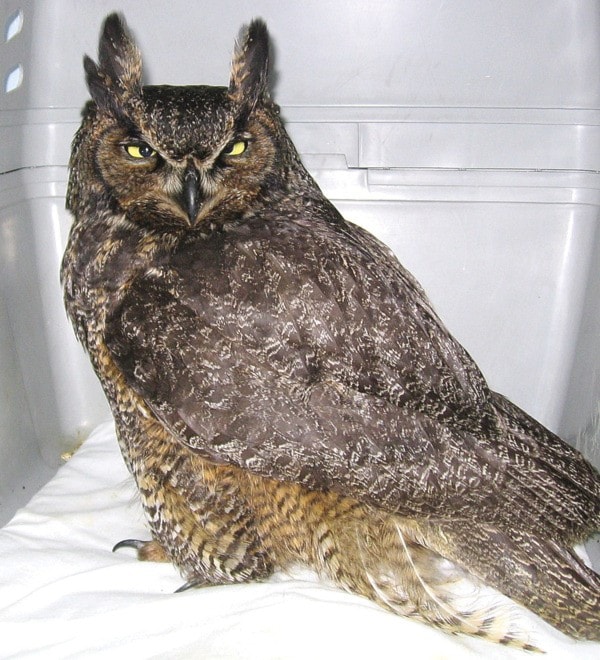One of the most successful predators in North America is aptly nicknamed “Tigers of the Skies.”
Powerful, fearless, and resourceful, great horned owls are also one of the longest lived owls in North America, having been known to survive for 28 years.
Closely resembling their feline counterparts, great horned owls are stealth-like hunters with acute hearing and relentless in their pursuit of prey. They are exceptional predators and have been known to tackle bobcats and other larger mammals when defending their territory.
Large and bulky looking birds, these owls are masters of disguise with plumage that is coloured to fit in with their habitat providing them with the perfect camouflage.
Standing between 46-63 centimetres in height, they have a huge wingspan of 101-145 cm. The females, the larger of the two, weigh between one- and two-and-a-half kilograms.
Great horns owls do not have actual horns, but ear tufts that resemble horns; these tufts are used to change the overall outline of a roosting bird allowing them to look like part of the tree, they can also be raised or lowered to show alarm.
Bright yellow eyes peer out of wide heads and their eyes are surrounded by tawny-coloured facial discs feathers, they also have a prominent white bib which can be seen to vibrate when the need to cool themselves down. Feathers vary in colour from dark brown to tawny, to light grey or sandy depending on their habitat.
These owls are found year round throughout North America, from the arctic tundra to Tierra del Fuego at the tip of South America. They live in a variety of habitats from coniferous, boreal and riparian forests, but are also at home in deserts, tundra and even urban areas.
Healthy populations of great horned owls can be attributed to the wide variety of food they prey upon which include, medium-sized mammals (particularly rabbits), smaller raptors and owls, small birds, amphibians, reptiles and even fish.
Great horned owls are nocturnal hunters although they will also hunt either side of dusk and dawn; they are high-performance, energy-burning hunting machines that constantly need to top up their fuel supplies and can consume up to 48 per cent of their body weight in food per day.
One of the more secretive owls, they are not often seen in the open during the day and it is always a thrill to see or hear them. They are one of the few owls that actually “hoot,” emitting a low resonant series of hoots that echo eerily in night.
I was lucky enough to have a pair of great horns in my area last fall, attracted I am sure by the abundant supply of displaced rabbits due to a new commercial development!
It’s not often that MARS (Mountainaire Avian Rescue Society) cares for these owls, especially the adults. Like many of our recent cases, the great horned owl we received last week had quite a story of his own to tell.
A skinny, bedraggled great horned owl was flown from Klemtu after an adventure in the ocean. The owl was pulled out of the water by the occupants of a float house and left to dry out on the dock.
However, it was relentlessly “mobbed” by the local crow and raven population and was taken indoors and put in a box with food and water to try and calm it down. The next day it appeared to look better and it was decided to release the owl rather than stress it further, and there had been another owl in the area.
However, once again, the owl landed in the water a few metres from the floating dock and this time it managed to swim to the rocks where the reception party of crows were waiting. Rescued again, it was put back in a box which it promptly escaped from and decide to spend the day perched on the dining room table.
After trying to entice the owl to fly it was obvious this was not going to happen and it was secured in another box. MARS was contacted to offer advice, and travel arrangements were made to fly the owl down to Campbell River and then to our centre in Merville.
On arrival the owl was very stressed and emaciated, and needed rehydration protocol before he could be introduced to whole food. The owl did not appear to have any outward signs of trauma, but was treated for parasites or a cause not visibly seen.
It is very important to follow basic steps if you find wildlife, any raptor that is not aggressive and will not fly, where safe, should be put in a securely covered box or kennel without food or water; MARS should be contacted for advice or a rescue arranged.
On another happy note, we are pleased to report that the last four remaining eagles, including “Semi,” were released this week it was amazing to see how they responded to their release, flying well then soaring on the wind free at last!
“Sooty” the barn owl was introduced in to a new barn in hopes he will find a new mate.
For upcoming events please check our web site at www.wingtips.org
To report injured, or orphaned wildlife please call toll free 1-800-304-9968.
